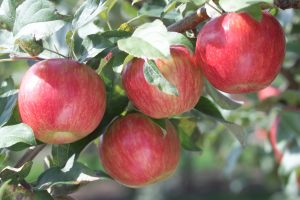
Courtesy U of MN.
Nearly 100 years ago, Charles Haralson, superintendent of the University of Minnesota’s Fruit Breeding Farm, developed a crisp, juicy, slightly tart apple. The Haralson, along with the Beacon, Fireside, and Regent, grew into mainstays for apple growers. But by the late 20th century, the U.S. apple industry was in a funk, depressed by low-cost apple imports that dominated market share but failed to excite apple lovers.
In 1991, the University unveiled the HoneycrispTM. “It decommoditized the market for apples,” said Schrankler. In 2006, the Better World Project credited the Honeycrisp apple with reinvigorating the struggling apple industry. “Because the price of apples in grocery stores had dropped to record lows, growers had to sell the fruit at below cost, and some orchards went out of business. But demand for Honeycrisp apples grew, and farmers had a new apple that they could sell at a premium.”[i]
Minnesota in the 1970s was probably known for its dandelion wine when a few growers formed the Minnesota Grape Growers Association. But the grape vines needed protection from the cold, stunting the industry’s growth in Minnesota. In 1978, Elmer Swenson, a longtime vineyard owner from Wisconsin and researcher with the University of Minnesota, released the cold hardy Swenson Red and Edelweiss grapes.[ii]
In the mid-1980s, the University opened a formal wine-grape breeding project, which has patented several cold hardy wine grapes that can survive Minnesota winters. The project includes more than 10 acres of research vineyards with 10,000 experimental vines. An accompanying enology program produces and evaluates wines.[iii]
A 2012 survey by the University of Minnesota received responses from 101 vineyards and 34 wineries. The report estimates that Minnesota’s wine industry supported 3,250 jobs and generated $59 million in economic activity through vineyards, wineries and wine tourism.[iv]
— Tom Teigen
[i] The Better World Project, Association of University Technology Managers. (2006.) Technology Transfer Works: 100 Cases From Research to Realization. Page 11.
[ii] Minnesota Grape Growers Association. History of the Minnesota Grape & Wine Industry, by Martell, Tom. (Accessed March 2014.)
[iii] University of Minnesota. Grapes: U of M Expertise. (Accessed March 2014.)
[iv] University of Minnesota. (June 2013.) Vineyards and Wineries in Minnesota: A Status and Economic Contribution Report, by Brigid Tuck and William Gartner. Page 2.
